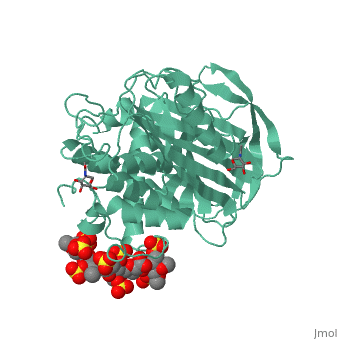User:Yunlong Zhao/Sandbox 1
Activation of antithrombin by heparinActivation of antithrombin by heparin
Heparin is often identified as a proteoglycan, in which heparin or heparin sulfate associates with other proteins in a strong intrinsic affinity. It has also been found that HS chains are usually localized on the surface of cells and the complex with matrix proteins. This interesting discovery suggests that HS usually exists as an “immobile phase” attaching antithrombin and activates its function as an anticoagulant factor in the circulation system. In an anticoagulant process, antithrombin needs to bind to some coagulant proteases such as Factor Xa or thrombin and “neutralizes” their activity. There are several hypotheses to explain how the heparin chains activate this process. A simple model is that a long heparin chain could be a scaffold to improve the possibility of antithrombin contacting with other proteins. [1] Another direct model is that specific sulfate-containing heparin fragments (oligosaccharides) can allosterically enhance the binding affinity between antithrombin and thrombin or Factor Xa. We are going to describe the structural basis of the second model in the rest of contexts. [2] Structure features and activation of latent antithrombinAntithrombin is a natural inhibitor of many serine proteases and it contains an exposed inhibitory loop to intrude the catalytic site of proteases. The peptide bond between R393-S394 plays a critical role in the inhibitory binding (Figure 1). However, the exposure of the inhibitory loop requires a conformational change during activation. In the latent state of antithrombin, this loop is fully buried in the four-strands beta sheet to form a new five-strands beta sheet. This remarkable conformational change of inhibitory loop highlights the activation mechanism of latent antithrombin. The mechanism of heparin regulating antithrombin thrombin interactionGreen scene 1 will be the interface between AT and thrombin Green scene 2 will be the the interface structure plus heparin
This is a sample scene created with SAT to by Group, and another to make of the protein. You can make your own scenes on SAT starting from scratch or loading and editing one of these sample scenes.
|
| ||||||||||
ReferencesReferences
- ↑ Lane DA, Denton J, Flynn AM, Thunberg L, Lindahl U. Anticoagulant activities of heparin oligosaccharides and their neutralization by platelet factor 4. Biochem J. 1984 Mar 15;218(3):725-32. PMID:6721831
- ↑ Olson ST, Bjork I, Sheffer R, Craig PA, Shore JD, Choay J. Role of the antithrombin-binding pentasaccharide in heparin acceleration of antithrombin-proteinase reactions. Resolution of the antithrombin conformational change contribution to heparin rate enhancement. J Biol Chem. 1992 Jun 25;267(18):12528-38. PMID:1618758
